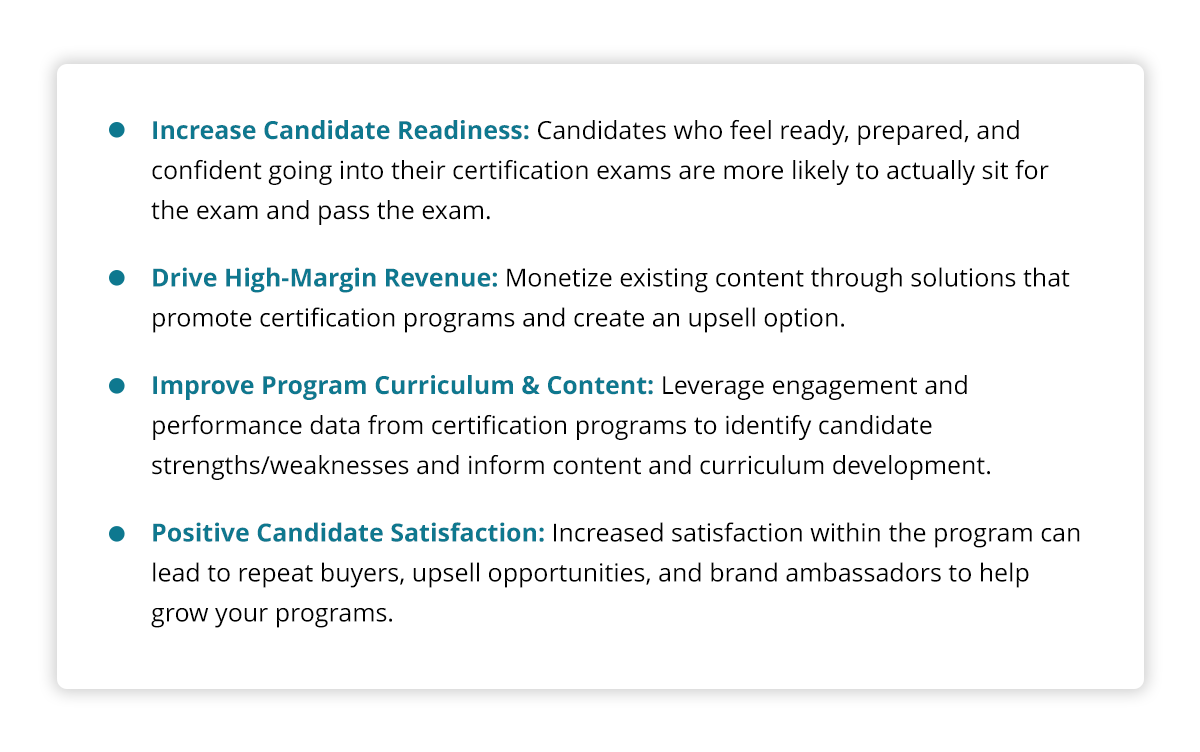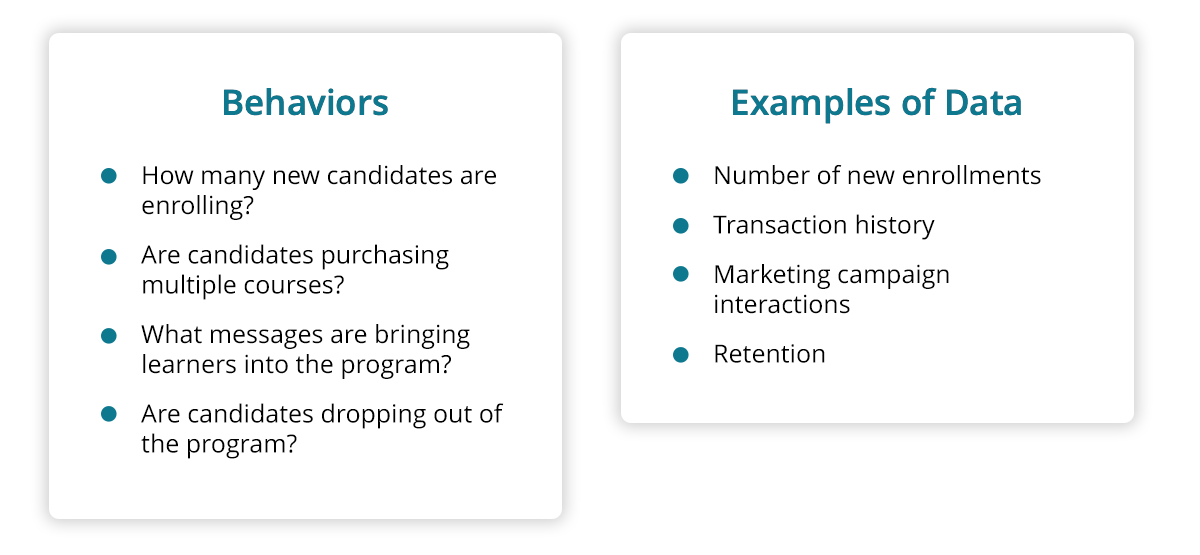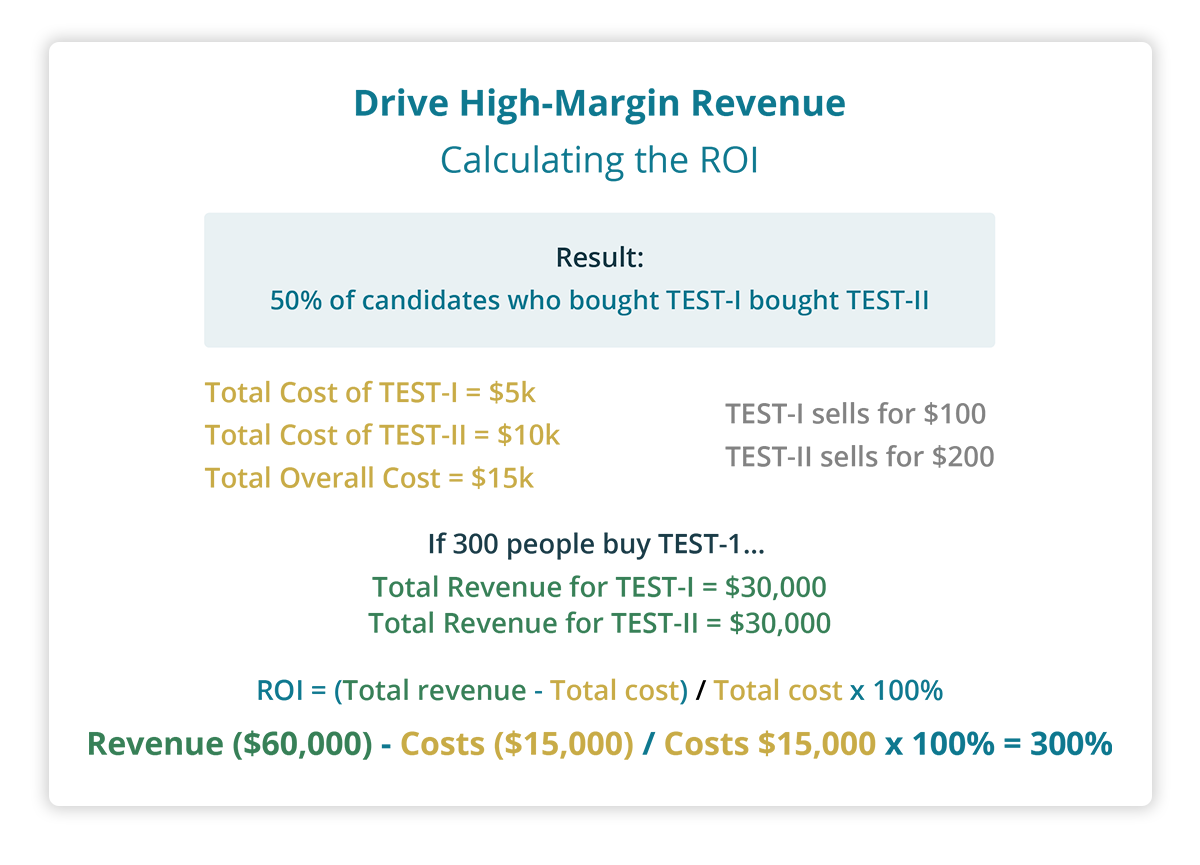Cultivating Success: How to Measure the Value and ROI of Certification Training
Measuring the value and return on investment (ROI) of certification training programs is a critical undertaking for organizations today. As the importance of certifications grows, so does the need to accurately assess the impact and effectiveness of these programs. However, many organizations face challenges when it comes to measuring the value and ROI of their certification training initiatives.
In this blog, we will explore key strategies and insights on how to effectively measure the value and ROI of certification training programs. By understanding the significance of supporting the entire candidate journey, setting clear objectives, and identifying relevant metrics, you will be equipped with the tools to demonstrate the impact of your certification training programs on candidates' success.
Supporting the Candidate Journey: Learn, Practice, Certify
As you know, learning is not a singular event—it’s a process or a journey. Think of this journey in three phases:
- Learn: In this stage, candidates acquire the knowledge and skills necessary to excel in their certification exams.
- Practice: Next, candidates put what they learned into practice via practice questions, mock exams, etc. The practice stage plays a vital role in building confidence and proficiency.
- Certify: In the last stage, candidates’ knowledge is put to the test—literally. Candidates will sit for their certification exams to apply their knowledge effectively and validate their expertise.

So... where does certification training come in?
Certification training falls within the learn and practice stages and supports the candidates in achieving their credentials. While real-world on-the-job experience is valuable, candidates may not get the knowledge and skills they need through that experience alone. Certification training can enable and further support them through knowledge acquisition.
Return on Investment (ROI) vs. Value of Investment (VOI)
Now that we’ve mastered the three stages of the candidate journey and aligned on certification training, let’s clarify the difference between ROI and VOI, and its business applications.
From a business perspective, ROI is usually determined by looking for direct monetary value by selling products, growing programs, and supporting your candidates. It’s an approximate measure of an investment’s profitability and typically includes tangible benefits like cost savings or revenue generated. From a candidate's perspective, some examples of ROI might be the time they get back from being able to study on the go, being able to pass the exam on their first attempt, or perhaps even the potential raise they might get based on an acquired credential.
From a business perspective, VOI can be thought of as intangible assets that contribute heavily to an organization’s performance. These assets include knowledge, processes, organizational structure, and the ability to collaborate. From a candidate’s perspective, examples of VOI might be the confidence they gain as they study and head into the exam, or even just the knowledge itself they gain from the program.
Determine Your Certification Training Program Objectives
Before we dive into measuring the ROI and value of your certification program, there are a few things we need to determine. First, you need to determine your program objectives. Here are a few common certification training program objectives:  With these objectives in mind, it’s also important to establish ways to measure success in your program. That way, you can see if you’re on track or if adjustments need to be made.
With these objectives in mind, it’s also important to establish ways to measure success in your program. That way, you can see if you’re on track or if adjustments need to be made.
Measuring ROI of Certification Training: Identify Behaviors, Get the Data, Do the Calculation
Data Metrics for Success
Data is the key to both candidate and business success. Having access to data about your candidates, such as their strengths and weaknesses, will allow you to make decisions based on information rather than assumptions or opinion, ultimately resulting in greater, more frequent triumphs. And, making sure your candidates have access to data about their progress will increase the value they see from your program.
From a business perspective, data can help inform strategy decisions or even content decisions by allowing stakeholders to see how effective specific education is, but also how important it is to the target audience.
However, before identifying what data to capture, it’s recommended to first identify candidate behaviors that will help bridge the gap between data and your objectives.
Candidate Behaviors
You might be wondering, what are “candidate behaviors”? Simply put, behaviors are data, just abstracted into plain English. They can be as broad as usage, performance, or satisfaction, or as specific as studying flashcards, taking exams, and recommending products to friends. 
The reason behaviors are important is that they provide focus and help to avoid some common data analysis traps. They force you to think about broad actions and find quantifiable examples of those actions.
Without this focus, you are at risk of answering the wrong question or trying to get your arms around so much data that you begin spinning your wheels. Behaviors help you make sure you are pulling data that aligns with your certification training program objectives.
Now, let’s look at an example: we will first determine our objective, identify behaviors, and pull data that support those behaviors.
Example: Driving High-Margin Revenue
In this example, we’ll focus on a common certification training program objective: driving high-margin revenue. When it comes to driving revenue, what are some behaviors you can identify? What data could you pull to help you measure those behaviors?
 For the sake of ease, all of the data examples above have tangible value. This makes calculating ROI much easier. However, don’t forget that depending on what you are measuring, there may be intangible values you need to consider as well…
For the sake of ease, all of the data examples above have tangible value. This makes calculating ROI much easier. However, don’t forget that depending on what you are measuring, there may be intangible values you need to consider as well…
Now, you are ready to calculate your ROI.
Calculating the ROI of Certification Training
Let’s hone in on one of our identified behaviors: are candidates purchasing multiple courses?
When we looked at the data, we noticed that 50% of candidates who purchased TEST-1 also bought TEST-II. To calculate the ROI you’ll want to consider how much it cost to create the two tests:
TEST-1: $5,000
TEST-11: $10,000
Now, you’ll want to determine how much you can sell these products for. Let’s say TEST-I sells for $100 and TEST-II sells for $200.
If 300 people bought TEST-1, you’ll generate $30,000 ($100 x 300). If 50% of those people bought TEST-II, you’ll generate an additional $30,000 (150 x $200) for a total of $60,000 in sales.
To get the ROI, the formula you’ll want to use is:
Total Revenue - Total Costs / Costs * 100
In this example, we see an ROI of 300%. This means that the ROI for the certification tests is 300%, which indicates that for every dollar invested in creating the tests, the organization generates a return of $3 in revenue.
Therefore, you can determine that certification training programs are a great way to drive high-margin revenue.
We frequently hear from our partners that they’ve gathered candidate feedback and know that their candidates often want collateral like digital mock exams and online practice questions. Providing them with these things not only helps them prepare for their exams but can also drive revenue for your business. It’s a win-win for everyone!
Conclusion: Cultivating Success Through Measurement
Measuring the value and ROI of certification training programs is vital for organizations aiming to enhance candidate success and drive business growth. By understanding the importance of supporting the candidate journey, setting clear objectives, and tracking relevant metrics, you can showcase the success of your programs.
To see these learnings applied to real-world success stories, check out our CompTIA case study where they partnered with BenchPrep to deliver effective digital certification training products and digital continuing education products, which met the needs of learners while also driving revenue for CompTIA.





